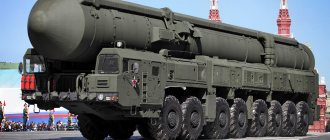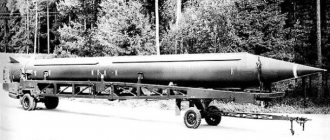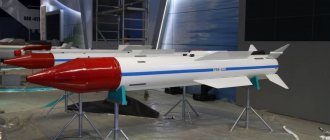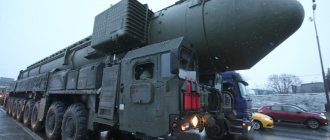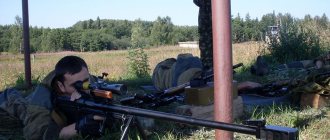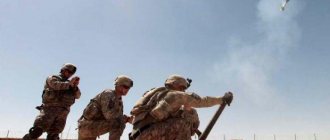Despite the fact that the Intermediate-Range Nuclear Forces Treaty (INF Treaty), which prohibits the production of land-based systems with a range of 500 to 5,500 km, is still in force, the US Army no longer hides its active work on “thousand-mile” missiles. The iz.ru portal is trying to briefly highlight the plans of the American military.
Russia advocated a frank dialogue with Washington on the INF Treaty
About history repeating itself
Many parallels can be drawn between the current military-political situation and the events of the 80s. Both then and now, the Western bloc was loudly concerned about the deployment of Russian medium-range missiles - then they were ballistic Pioneers, and today they are complexes with 9M729 cruise missiles. Both then and now, Moscow tried to link the issues of reducing offensive weapons with obligations not to begin the militarization of space and the deployment of a global missile defense system. Both then and now, the need to “respond to the threat” is used in the United States to justify the development of new missile systems.
Pershing
Medium-range missile system RSD-10 "Pioneer"
Photo: RIA Novosti/Anton Denisov
Shorter-range sanctions
Why the White House is accusing Russia of violating a key security agreement
However, there are many differences. “Pioneers” are more than real and are in large-scale production, 9M729 have a semi-mythical character, since over the past year and a half (if you count from the beginning of the public escalation of claims, which coincided with the publication of the “leak” in an article by The New York Times) no evidence of their prohibited range has been presented, as well as any details about them. Attempts to contain the militarization of space, unlike in the 80s, are clearly doomed to failure, and the treaty limiting the missile defense system ceased to operate in 2002. If at the turn of the 70s and 80s the alarm bell was sounded about new Soviet missiles primarily in Europe, and the United States reacted with hastily made ersatz, but now most of the concern about “Russian missiles threatening Europe” is manifested from overseas, there New missile programs have already started, and the European NATO allies themselves react to the Americans’ desire to urgently save them rather coolly, even demonstrating discord in the matter of proving Russian violations and the seriousness of the problem as a whole.
Author of the quote
During the first Euromissile crisis, the United States created and deployed in Europe in response to the Pioneers the Griffon (ground-based version of the Tomahawk) and Pershing 2 (modified Pershing 1a with increased range and accuracy) missile systems. A clear demonstration that they left much to be desired is the fact that the main horror story of that time - the ability of the United States to deliver an instant decapitating blow to the military-political leadership of the Pershings - was not entirely true. The American missile simply did not have the range to hit Moscow, even if only slightly.
US Congress extends Trump's authority to withdraw from INF Treaty
However, the fact that someone does not ask for protection should not stop them from seeking to provide it. In addition, although it is declared that all recent measures are aimed at “containing Russia” and even “persuading it to return to compliance with the INF Treaty,” no, no, another addressee is slipping through, which did not sign the INF Treaty at all: China. So, last year, at a hearing in the Senate, the head of the Pacific Command, Admiral G. Harris, said that, of course, the United States must comply with the INF Treaty, since they signed it, but for him personally in the Pacific Ocean, “prohibited” range complexes would be very useful to deter China .
So far, the main military-technical measure, which has received funding for the second year under the INF Treaty Preservation Law, is the development of a ground-mobile complex with a cruise missile with a range falling within the limits of the treaty and equipped with a non-nuclear warhead. The United States insists that, according to the letter of the treaty, development up to the stage of production and testing of prototypes is legal and they are ready to abandon further stages if Russia “fully and verifiably” returns to compliance with the INF Treaty. Considering that our side denies the very fact of violations, which the United States, in turn, considers fully proven, there is no need to wait for a compromise here yet. So, after the end of the “paper” stage, the new American complex will probably begin testing, and the INF Treaty will be declared “temporarily suspended” by the States. Perhaps this will happen next year.
Pershing
Signing of the Soviet-American INF Treaty. The agreement was signed by: General Secretary of the CPSU Central Committee Mikhail Sergeevich Gorbachev and US President Ronald Reagan
Photo: RIA Novosti/Yuri Abramochkin
CSTO Foreign Ministers adopted a statement on the INF Treaty
New - well forgotten old
The new missile and the Pershing
Comparing the new ballistic missile with its direct predecessor, the Pershing II MRBM, one can see many similarities. First of all, let's pay attention to the head of the rocket. Apparently, it is equipped with the same maneuvering warhead, known as the Goodyear MARV, as the Pershing II (however, the launched missile most likely carried a mock-up). This indicates the missile's expected high accuracy and ability to penetrate missile defenses.
Apparently, combat missiles will use a combination of inertial guidance (the most reliable and not subject to interference), GPS guidance (the most accurate and quickly adjustable) and radar homing. It is likely that the missile will be equipped with a millimeter-wave scanning radar. Such radars, capable of constructing an image of a target with a narrow beam and comparing it with the one included in the flight mission, are already used on controlled aerial bombs.
Design of the warhead of the Pershing II missile
According to the military statement, the missile was tested conventionally-configured, that is, in non-nuclear configuration. Which, of course, clearly hints at possible (if necessary) nuclear equipment. Pershing II missiles were once equipped with W85 nuclear warheads, a variant of the very successful atomic charge from the B61 aerial bomb. After the Pershing II was decommissioned, its warheads were converted into charges for B61-10 bombs and placed in storage as the so-called “inactive reserve”. It is clear that it will not be difficult to remove bombs from a warehouse and convert them back into missile warheads!
It is also possible that the W76-2 low-yield tactical warheads, the development of which is currently receiving considerable attention, will be used to equip new ballistic missiles.
In a non-nuclear configuration, the missile will most likely be equipped with either a WDU-43/B penetrating warhead from Tomahawk missiles (to destroy protected targets) or a cluster warhead (to destroy area targets and troop concentrations). More exotic solutions are also possible - for example, a CBU-97 cluster warhead with homing anti-tank ammunition or a warhead that delivers loitering drones to the target.
It is interesting to note that the new ballistic missile appears to be a single-stage missile. In the video posted there is no sign of separation of the steps. But it is clearly noticeable how the rocket engine flame expands as it climbs. This is typical for a narrow “atmospheric” nozzle operating at high altitudes, where air pressure no longer compresses the jet stream. A two-stage rocket would have a wide “vacuum” nozzle on the second stage.
Expanding rocket engine plume
Therefore, there was an assumption that the new ballistic missile was built on the basis of a solid propellant stage from a commercial launch vehicle. Orion 50S XL was indicated as a possible candidate - about ten meters long and 1.3 meters in diameter. Its burn time is about 70-75 seconds, which is quite comparable to the total burn time of the two stages of the Pershing (38 + 39 = 77 seconds). Of course, the range of the new missile is still kept secret, but it can be assumed that it will be comparable to the range of the same Pershing. That is, at least 1500 km.
Literature
- Vladimirov K.
56th brigade of the Pershing missile defense (Russian) // Foreign Military Review. - M.: “Red Star”, 1985. - No. 7. - P. 17-20. — ISSN [www.sigla.ru/table.jsp?f=8&t=3&v0=0134-921X&f=1003&t=1&v1=&f=4&t=2&v2=&f=21&t=3&v3=&f=1016&t=3&v4=&f=1016&t=3&v5 =&bf=4&b=&d=0&ys=&ye=&lng=&ft=&mt=&dt=&vol=&pt=&iss=&ps=&pe=&tr=&tro=&cc=UNION&i=1&v=tagged&s=0&ss=0&st=0&i18n=ru&rlf=&psz =20&bs=20&ce=hJfuypee8JzzufeGmImYYIpZKRJeeOeeWGJIZRrRRrdmtdeee88NJJJJpeeefTJ3peKJJ3UWWPtzzzzzzzzzzzzzzzzbzzvzzpy5zzjzzzzzzzzzzzzzzzzzzzzzzzzz zzzzztzzzzzzbzzzzzzzzzzzzzzzzzzzzzzzzzzzzzzzzzyeyTjkDnyHzTuueKZePz9decyzzLzzzL*.c8.NzrGJJvufeeeeeJheeyzjeeeeJh*peeeeKJJJJJJJJJmjHvOJJJJJJJJfe eeieeeeSJJJJSJJJ3TeIJJJJ3..E.UEAcyhxD.eeeeeeuzzzLJJJJ5.e8JJJheeeeeeeeeeeeyeeK3JJJJJJJJ*s7defeeeeeeeeeeeeeeeeeeeeeeeeSJJJJJJJZIJJzzz1..6LJJJJJJtJJZ4….EK*&deb ug=false 0134-921X].
Links
- rbase.new-factoria.ru/missile/wobb/pershing_1a/pershing_1a.shtml
| : Incorrect or missing image | To improve this article it is desirable:
|
| SLBM | UGM27A Polaris A1 UGM27B Polaris A2 UGM27C Polaris A3 Polaris A3TK UGM73A Poseidon C3 UGM-96A Trident I C4 UGM-133A Trident II D5 |
| MGM-1 Matador RGM-6 Regulus AGM-12D Bullpup MGM-13 Mace RGM-15 Regulus II AGM-28 Hound Dog AGM-69 SRAM AGM-86 ALCM RGM/UGM-109A Tomahawk AGM -129 ACM | |
| late MRBMs and tactical | MGR-1A Honest John MGR-3 Little John MGM-5 Corporal PGM-11 Redstone MGM-18 Lacrosse MGM-29 Sergeant MGM-31 Pershing 1A MGM- 31B Pershing 2 MGM-52 Lance |
| V-V, P-V and P-P | AIR-2 Genie · BOAR · RIM-2D Terrier · RIM-8 Talos · CIM-10 Bomarc · MIM-14 Nike-Hercules · AIM-26 Falcon · RUR-5 ASROC · UUM-44 SUBROC · AGM-48 Skybolt · LIM -49 Nike Zeus/LIM-49A Spartan Sprint AGM-62 Walleye |
| not included in the series | RIM-50 Typhon LR AIM-68 Big Q BGM-110 RUM/UUM-125 Sea Lance AGM-131 SRAM II |
| Air-to-surface missiles (AGM) | AGM-12 • AGM-22 • AGM-28 • AGM-45 • AGM-48 • AGM-53 • AGM-65 • AGM-69 • AGM-78 • AGM-79 • AGM-80 • AGM-83 • AGM- 84 • AGM-87 • AGM-88 • AGM-109 • AGM-114 • AGM-119 • AGM-123 • AGM-124 • AGM-129 • AGM-129 • AGM-130 • AGM-142 • AGM-154 • AGM-158 |
| Cruise missiles | MGM-1 • MGM-13 • RGM-6 • RGM-15 • SM-62 • SM-64 • AGM-86 • BGM-109 |
| Anti-aircraft missiles and systems, anti-missiles | RIM-2 • MIM-3 • RIM-7 • RIM-8 • CIM-10 • MIM-14 • MIM-23 • RIM-24 • FIM-43 • MIM-46 • LIM-49 • RIM-59 • RIM- 55 • RIM-66 • RIM-67 • MIM-72 • FIM-92 • MIM-104 • MIM-115 • RIM-116 • MIM-146 • RIM-161 • RIM-162 • RIM-174 |
| Ballistic missiles | MGM-5 • PGM-11 • HGM-16 • PGM-17 • MGM-18 • PGM-19 • LGM-25 • UGM-27 • MGM-29 • LGM-30 • MGM-31 • MGM-52 • UGM- 73 • UGM-96 • LGM-118 • UGM-133 • MGM-134 • MGM-140 |
| Anti-tank guided missiles | BGM-71 • FGM-77 • FGM-148 • MGM-21 • MGM-32 • MGM-51 • MGM-166 |
| Anti-ship missiles | AGM/RGM/UGM-84 • AGM-119 |
| Anti-submarine missiles (RUM) | RUR-5 • RUM-139 |
| Anti-satellite missiles | ASM-135 |
| Unguided missiles, guided bombs | MGR-1 • AIR-2 • AGM-62 • GBU-15 |
| Experimental rockets | AAWS-M • IMAAWS • • • Assault Breaker • Tank Breaker (HAC · MD/RCA · RIC · ) |
| Starting in 1986, letters began to be used to indicate the launch environment/target in the index. "A" for air assets, | |


